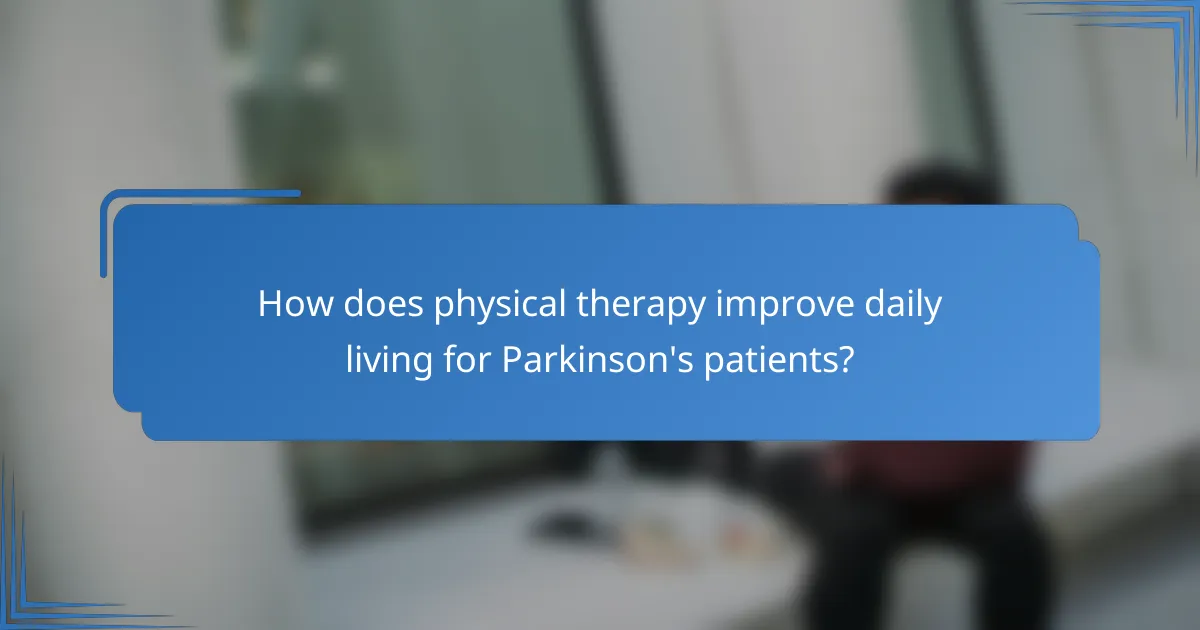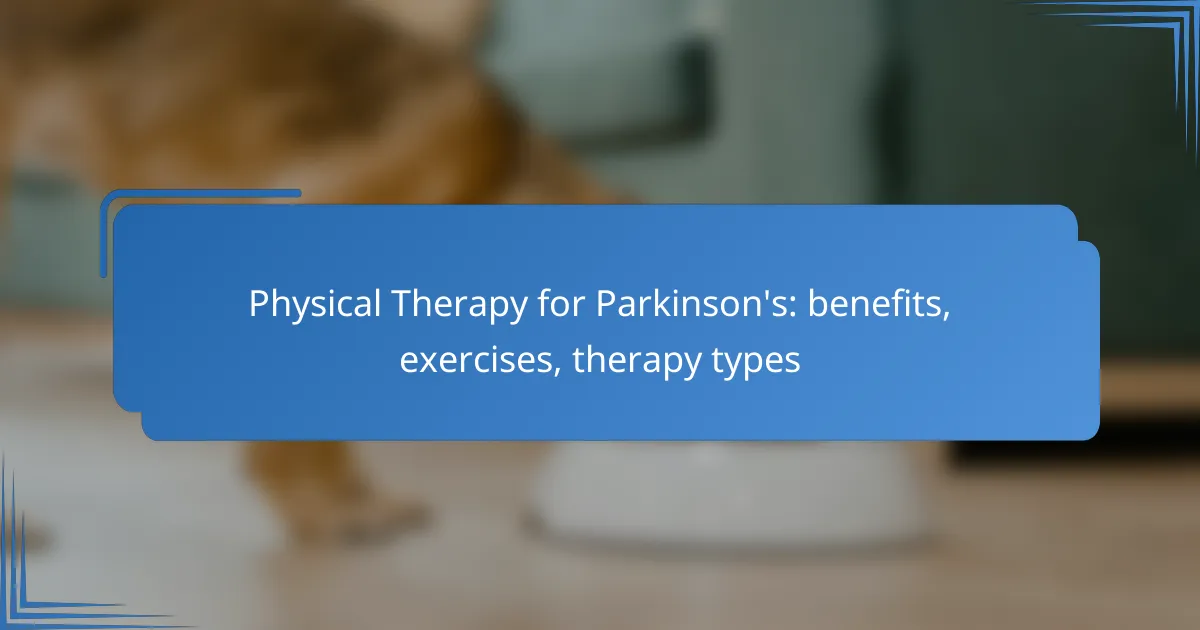Physical therapy plays a crucial role in enhancing the quality of life for individuals with Parkinson’s disease by focusing on improving movement and overall well-being. Through tailored exercises and diverse therapy types, patients can experience significant gains in mobility, strength, and daily functioning, ultimately leading to a more active and fulfilling life.

What are the benefits of physical therapy for Parkinson’s in New Zealand?
Physical therapy offers numerous benefits for individuals with Parkinson’s disease in New Zealand, focusing on improving movement and enhancing overall well-being. By engaging in tailored exercises and therapies, patients can experience significant improvements in their daily activities and quality of life.
Improved mobility
Physical therapy can greatly enhance mobility for those with Parkinson’s. Through specific exercises, patients work on strength, flexibility, and coordination, which can lead to smoother and more controlled movements. Regular sessions can help individuals regain the ability to perform daily tasks with greater ease.
Therapists often incorporate gait training and functional mobility exercises, which focus on walking patterns and transitions between positions. This targeted approach helps patients navigate their environments more confidently.
Enhanced balance
Balance issues are common in Parkinson’s patients, making falls a significant concern. Physical therapy addresses this by incorporating balance training exercises that strengthen core muscles and improve stability. These exercises often include activities like standing on one leg or using balance boards.
Additionally, therapists may use techniques such as tai chi or yoga, which emphasize controlled movements and body awareness, further enhancing balance and reducing fall risk.
Reduced muscle stiffness
Muscle stiffness is a frequent symptom of Parkinson’s that can limit mobility. Physical therapy employs stretching and range-of-motion exercises to alleviate this stiffness. These exercises help maintain muscle elasticity and joint flexibility, making movement more comfortable.
Therapists may also use techniques like massage or heat therapy to relax tight muscles, providing immediate relief and promoting better movement patterns.
Increased independence
One of the primary goals of physical therapy for Parkinson’s is to foster greater independence in daily activities. By improving mobility, balance, and strength, patients can perform tasks such as dressing, cooking, and walking without assistance. This newfound independence can significantly boost self-esteem and confidence.
Therapists often work with patients to develop personalized strategies for managing daily activities, ensuring that individuals can maintain their routines as much as possible.
Better overall quality of life
Engaging in physical therapy can lead to a marked improvement in the overall quality of life for those with Parkinson’s. By addressing physical limitations, patients often experience enhanced emotional well-being and social engagement. Regular physical activity can also reduce feelings of depression and anxiety.
Moreover, the social interaction that occurs during therapy sessions can foster a sense of community and support, which is crucial for mental health. Overall, the benefits of physical therapy extend beyond physical improvements, contributing to a more fulfilling life.

What types of physical therapy are available for Parkinson’s?
Physical therapy for Parkinson’s includes various approaches tailored to improve mobility, strength, and overall quality of life. The main types are individualized therapy programs, group therapy sessions, and occupational therapy integration, each offering unique benefits for managing symptoms.
Individualized therapy programs
Individualized therapy programs are specifically designed to meet the unique needs of each Parkinson’s patient. These programs typically involve one-on-one sessions with a licensed physical therapist who assesses the patient’s physical abilities and limitations.
Therapists may focus on exercises that enhance balance, flexibility, and strength, often incorporating techniques like stretching, resistance training, and gait training. Patients should expect sessions to be tailored to their specific goals, whether that’s improving daily function or preparing for a specific activity.
Group therapy sessions
Group therapy sessions provide a supportive environment where individuals with Parkinson’s can engage in physical activities together. These sessions often include exercises that promote social interaction and motivation, which can enhance the overall experience of therapy.
Participants may benefit from structured activities such as dance, tai chi, or circuit training, which not only improve physical health but also foster a sense of community. Group settings can help reduce feelings of isolation and encourage adherence to exercise routines.
Occupational therapy integration
Occupational therapy integration focuses on helping patients perform daily activities more effectively. This type of therapy works alongside physical therapy to address practical challenges faced in everyday life, such as dressing, cooking, or managing personal care.
Occupational therapists may recommend adaptive tools and techniques that facilitate independence, such as using grab bars or specialized utensils. By combining physical and occupational therapy, patients can achieve a holistic approach to managing their symptoms and enhancing their quality of life.

What exercises are recommended for Parkinson’s patients?
Parkinson’s patients are encouraged to engage in a variety of exercises tailored to their specific needs, focusing on strength, flexibility, balance, and cardiovascular health. These exercises can help improve mobility, reduce stiffness, and enhance overall quality of life.
Strength training exercises
Strength training exercises are vital for Parkinson’s patients as they help build muscle mass and improve functional strength. Resistance bands, light weights, or bodyweight exercises like squats and lunges can be effective. Aim for sessions 2-3 times a week, focusing on major muscle groups.
Patients should start with low resistance and gradually increase as strength improves. It’s essential to maintain proper form to prevent injury, and working with a physical therapist can provide personalized guidance.
Stretching routines
Stretching routines help maintain flexibility and reduce muscle stiffness, which is common in Parkinson’s patients. Incorporating stretches for the neck, shoulders, back, and legs can enhance mobility. Aim for daily stretching sessions lasting 10-15 minutes.
Static stretches, where a position is held for 15-30 seconds, are particularly beneficial. Patients should listen to their bodies and avoid pushing into pain to prevent injury.
Balance exercises
Balance exercises are crucial for preventing falls, a significant risk for those with Parkinson’s. Simple activities like standing on one leg, heel-to-toe walking, or using a balance board can improve stability. Incorporate balance training into workouts 2-3 times a week.
Using support, such as a chair or wall, can help patients feel more secure while practicing balance. Gradually increasing the challenge level can further enhance stability and confidence.
Aerobic activities
Aerobic activities, such as walking, cycling, or swimming, are excellent for cardiovascular health and overall fitness. Aim for at least 150 minutes of moderate aerobic activity per week, broken into manageable sessions. Activities should be enjoyable to encourage consistency.
Patients should choose low-impact options to minimize joint stress and consider group classes for social interaction and motivation. Monitoring heart rate can help ensure that exercise intensity remains within a safe range.

How does physical therapy improve daily living for Parkinson’s patients?
Physical therapy significantly enhances daily living for Parkinson’s patients by improving mobility, balance, and overall physical function. Through targeted exercises and therapeutic techniques, patients can regain independence and manage symptoms more effectively.
Enhances daily function
Physical therapy helps Parkinson’s patients enhance their daily function by focusing on exercises that improve strength, flexibility, and coordination. Activities such as stretching, resistance training, and balance exercises can lead to better mobility and reduced risk of falls.
For example, simple exercises like walking, tai chi, or yoga can be integrated into daily routines to promote physical health. Patients should aim for at least 150 minutes of moderate exercise each week, which can be broken down into manageable sessions.
Promotes social engagement
Engaging in physical therapy can also promote social interaction among Parkinson’s patients. Group therapy sessions or classes provide opportunities to connect with others facing similar challenges, fostering a sense of community and support.
Participating in social activities, such as dance classes or walking groups, can enhance motivation and enjoyment in physical activity. Patients are encouraged to seek out local programs or community centers that offer specialized classes tailored for individuals with Parkinson’s.

What should you consider when choosing a physical therapist for Parkinson’s?
When selecting a physical therapist for Parkinson’s, prioritize their expertise in treating neurological conditions and their familiarity with the specific challenges faced by individuals with Parkinson’s. A therapist with the right background can tailor a program that effectively addresses mobility, balance, and strength issues.
Experience with neurological conditions
Choosing a physical therapist with experience in neurological conditions is crucial for effective treatment. Therapists who specialize in this area understand the unique symptoms and progression of Parkinson’s, allowing them to create targeted exercise regimens that enhance mobility and reduce fall risk.
Look for therapists who have worked with Parkinson’s patients specifically, as they will be familiar with the latest evidence-based practices. You can inquire about their training, certifications, and past patient outcomes to gauge their expertise.
Additionally, consider therapists who are familiar with multidisciplinary approaches, collaborating with neurologists and occupational therapists to provide comprehensive care. This teamwork can lead to more effective management of symptoms and improved quality of life.
